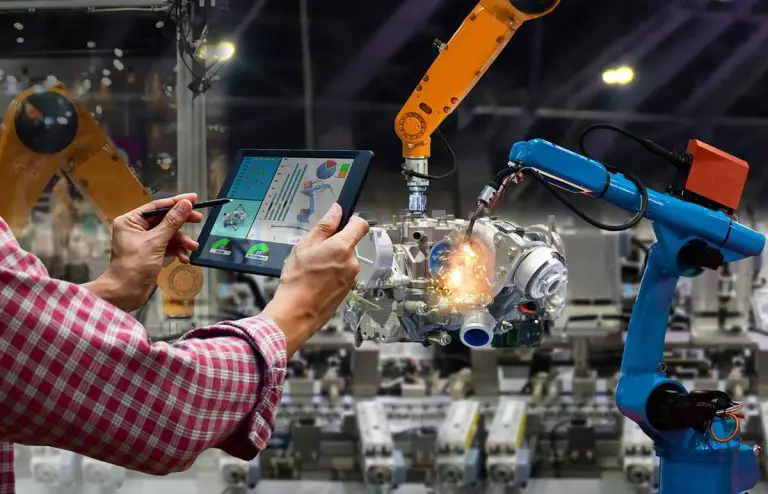The industrial automation industry is no longer a scene from science fiction; it's a rapidly evolving reality shaping the future of manufacturing. This blog delves into the heart of this dynamic sector, exploring the industrial automation services market, the role of key players, and the latest trends in industrial automation that are transforming manufacturing processes globally.
Power of Industrial Automation Services
This industry extends far beyond just hardware and software. It thrives on a robust industrial automation market, projected to reach a staggering USD 541.8 billion by 2027. These services are crucial for ensuring seamless implementation and optimal performance of automation systems. Here's a breakdown of some key service offerings:
- System Design & Integration: Experts assist companies in planning, designing, and implementing customized automation solutions tailored to their specific needs. This segment is expected to reach a market size of USD 18.02 billion by 2025.
- Installation & Commissioning: Ensuring proper installation, testing, and configuration of automation systems is vital for smooth operation. This service ensures everything functions as intended from the get-go.
- Maintenance & Support: Providing ongoing maintenance, troubleshooting, and technical support is essential to guarantee optimal performance and system uptime. The global market size for maintenance and support is estimated at USD 40.2 billion in 2023.
- Training & Education: Equipping staff with the necessary skills to effectively operate and manage automated processes is crucial for successful integration.
The market is projected to grow at a similar or even faster pace than the overall industry. This growth is driven by the increasing complexity of automation systems and the growing demand for specialized expertise to manage them effectively.
A Diverse Ecosystem: Industrial Automation Companies
The industry boasts a diverse range of companies offering a variety of automation solutions:
- Automation Technology Providers: Companies like Siemens, Rockwell Automation, ABB, etc., are the backbone of the industry. They develop and manufacture the essential building blocks of automation, including industrial robots, PLCs, SCADA systems, and other key components. (For instance, Siemens' global revenue in automation technologies reached a staggering €18.1 billion in 2022)
- System Integrators: Honeywell, Schneider Electric, Emerson, and similar companies specialize in designing, integrating, and implementing complete automation solutions. They act as one-stop shops, customizing automation systems to meet specific client needs.
- Industrial Automation Service Providers: Companies like Tech Mahindra, Accenture, Capgemini, etc., offer consulting, engineering, and implementation services for industrial automation projects. They bring expertise in planning, managing, and executing complex automation initiatives.
The Cutting Edge: Latest Trends
The industrial automation industry is constantly evolving, with exciting trends shaping its future:
- The Rise of Industry 4.0: This movement emphasizes the integration of smart technologies like Artificial Intelligence (AI), Machine Learning (ML), and the Industrial Internet of Things (IIoT) into industrial automation. The global IIoT market in manufacturing is expected to reach a massive USD 853.34 billion by 2027. This allows for increased automation, data-driven decision-making, and improved operational efficiency.
- Collaborative Robotics: Co-bots are robots designed to work safely alongside humans, performing tasks like material handling and assembly line support. This fosters human-machine collaboration, leveraging the strengths of both for enhanced productivity. The collaborative robot market is projected to reach USD 14.32 billion by 2027.
- Cloud-Based Automation: Cloud computing provides access to advanced automation functionalities and data analytics capabilities without significant on-premise infrastructure investment. This allows for greater scalability, flexibility, and remote access for system management. The cloud-based industrial automation market is expected to reach USD 23.44 billion by 2027.
- Focus on Sustainability: Energy-efficient automation solutions and automation supporting circular economy practices are gaining traction. Companies are striving for environmental responsibility by minimizing resource consumption and waste generation through optimized automation processes.
Top Industrial Automation Companies
Several global leaders consistently rank among the top industrial automation companies. These companies are recognized for their extensive product portfolios, global reach, and strong track records. Some key players include Siemens, Rockwell Automation, ABB, Bosch Rexroth, and Mitsubishi Electric. (For example, Rockwell Automation's revenue in 2023 was USD 8.2 billion)
However, the industry is not limited to established giants. Emerging players and startups are also contributing to the dynamism of the sector. They are innovating in specific areas like:
- AI-powered vision systems: These systems offer enhanced quality control, defect detection, and predictive maintenance capabilities.
- Cloud-based automation platforms: These platforms provide user-friendly interfaces and remote access for managing automation systems, reducing reliance on on-premise infrastructure.
- Collaborative robots with advanced functionalities: These co-bots are equipped with improved dexterity, vision capabilities, and safety features, enabling them to handle a wider range of tasks.
Market Growth Drivers: A Booming Industry
Several factors are fueling the significant growth of the industrial automation industry:
- Rising Labor Costs: Global manufacturing labor costs are expected to rise by 3.2% in 2024. Automation helps manufacturers address these rising costs by increasing production efficiency and reducing reliance on human labor.
- Increasing Demand for Product Quality and Consistency: Automation ensures consistent product quality by minimizing human error and maintaining precise control parameters. This is crucial for manufacturers to remain competitive in a global market.
- Growing Adoption of Industry 4.0 Technologies: The integration of AI, ML, and IIoT enables data-driven decision-making, predictive maintenance, and optimized production processes. This is driving the adoption of automation solutions across industries.
- Focus on Operational Efficiency and Productivity: Automation empowers manufacturers to streamline production processes, reduce waste, and shorten lead times. This translates to increased profitability and a competitive edge.
The global industrial automation market is projected to reach a staggering USD 1.8 trillion by 2027. This growth signifies the immense potential of automation to revolutionize manufacturing and contribute to global economic expansion.
The Road Ahead: Embracing Transformation

This industry presents a dynamic and exciting landscape with the potential to:
- Increase manufacturing efficiency: Automation streamlines processes minimizes downtime and optimizes resource utilization.
- Enhance product quality: Automated systems ensure consistent product quality by minimizing human error and maintaining precise control parameters.
- Improve worker safety: Automation takes over repetitive and potentially hazardous tasks, creating a safer work environment for human employees.
- Drive economic growth: The increased efficiency and productivity enabled by automation contribute to economic expansion and global competitiveness.
However, to unlock the full potential of industrial automation, stakeholders need to address some key challenges:
- Integration Challenges: Successfully integrating various automation components and systems into a cohesive whole requires careful planning and expertise.
- Cybersecurity Concerns: Securing industrial automation systems against cyberattacks is critical to protect operational integrity and prevent data breaches.
- Skilled Workforce Needs: The industry requires a skilled workforce to manage, maintain, and develop advanced automation systems. Continuous training and skill development are essential.
Conclusion: A Future Powered by Automation
The industrial automation industry is on the cusp of a transformative era. By embracing new technologies, addressing challenges, and fostering a skilled workforce, stakeholders can unlock the vast potential of automation to create a more efficient, sustainable, and future-proof manufacturing sector. As Henry Ford, the pioneer of assembly line production, once said, “Coming together is a beginning; keeping together is progress; working together is success.” The future of industrial automation hinges on successful collaboration between manufacturers, technology providers, and service companies, working together to shape a brighter future for global manufacturing.





